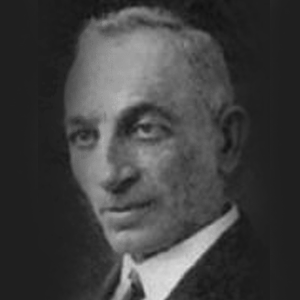Born 1860 in Belaya Tserkov, Kiev Gubernia, Ukraine. In his early youth he began to sing with the municipal cantor in the large Beit HaMedrash, R’ Motl Minkovsky (father of Pinye). After Pinye’s departure, S. continued as the only soloist and note reader in the chorus. Later he became conductor for Cantor Shmuel Folishuk. He married, and with a gdn became a merchant. For a short time he did good business, then lost his money, and in 1888 immigrated to America.
Here S. was from the first conductor in the synagogues with the cantors Kuper, Karnial, Grafman et al.
At the same time he also conducted and studied with the chorus in the Yiddish theatre, earlier as an assistant to Mogulesko, then as an independent composer and conductor.
1889 — he stage-directed in a dramatic circle and staged in Turn (Turin) Hall (Fourth Street) Goldfaden’s “Dr. Almasado” (in which Boaz Young debuted as “Bartelo”).
On 21 September 1896 in the Windsor Theatre, there was staged Joseph Lateiner’s operetta “Kidush Hashem”, or. The Jewish Minister” with S.’s music.
S. also wrote music for the operettas “Gbur hakhil” and for “Berukhah”, or, Der Yidisher kenig fun poyln oyf eyn nakht”, by Prof. M. Horowitz (1896), in which the music for the song “Eli, Eli, lmh ezbtni” [according to Boris Thomashefsky — the text of the songs were written by him] had an extraordinary success, and the play due to the performance became week-long.
This song later became one of the popular Yiddish compositions in the world and was sung in concerts by folks- and opera singers, as well as by cantors. In America this song, with the varieties, was sung by Rosa Raisa, Sofia Breslau, Bella Baker, Al Jolson et al.
The song was printed by a music company, and S., demanded his honorarium, led a protest that found a strong resonance in the press.
In the last years the song was made especially popular by Cantor Yosele Rosenblatt, who also sang with a flute, and was published with his arrangement with a foreword in Yiddish and English, in which there was said among other things: “There was never a more popular song in Yiddish music as “Eli, Eli”. Not only among Jews, but also among other nationalities, “Eli, Eli” came to be the song that brought out sadness and determination in his [the Jews] belief. Who created the song or the music isn’t entirely clear. In only a couple of years, “Eli, Eli” became famous, [amd] the old musician Jacob Sandler and the theatre director Boris Thomashefsky in management partnership [gained] recognition for the song, because it was sung in one of their operettas. However, it never was in doubt that it had a much earlier history. People who had remembered, recalled that the song had been heard in various parts of Europe and then was a “folk song”. It was found that the music also was portrayed among the composers to be of a cantor from the last generation, as the music of a piece of Slichot.”
For a certain time, S. also was a composer and director in the First Street Theatre in Philadelphia. Then he entirely withdrew from Yiddish theatre, and from time to time only conducted choruses for the High Holidays.
In March 1931, passed away in New York.
BIBLIOGRAPHY:
Z. Zylbercweig, in: Leksikon fun Yidishn Teater, 4 (1934), 1514–15.


10 thoughts on “Kaminos”
Was Nicholas related to Alexander Saslavsky who married Celeste Izolee Todd?
Anyone have a contact email for Yair Klinger or link to score for Ha-Bayta?
wish to have homeland concert video played on the big screen throughout North America.
can organize here in Santa Barbara California.
contacts for this needed and any ideas or suggestions welcomed.
Nat farber is my great grandpa 😊
Are there any movies or photos of max kletter? His wife’s sister was my stepmother, so I’m interested in seeing them and sharing them with his wife’s daughter.
The article says Sheb recorded his last song just 4 days before he died, but does not tell us the name of it. I be curious what it was. I’d like to hear it.
Would anyone happen to know where I can find a copy of the sheet music for a Gil Aldema Choral (SATB) arrangement for Naomi Shemer’s “Sheleg Al Iri”. (Snow on my Village)?
Joseph Smith
Kol Ram Community Choir, NYC
שלום שמעון!
לא שכחתי אותך. עזבתי את ישראל בפברואר 1998 כדי להביא את בני האוטיסט לקבל את העזרה המקצועית שלא הייתה קיימת אז בישראל. זה סיפור מאוד עצוב וטרגי, אבל אני הייתי היחיד עם ביצים שהביא אותו והייתי הורה יחיד בשבילו במשך חמישה חודשים. הוא היה אז בן 9. כעת הוא בן 36 ומתפקד באופן עצמאי. נתתי לו הזדמנות לעתיד נורמלי. בטח, אבות כולם חרא, אומרים הפמינציות, אבל כולם צריכים לעבוד כמטרות במטווחי רובה!
משה קונג
(Maurice King)
Thank you for this wonderful remembrance of Herman Zalis. My late father, Henry Wahrman, was one of his students. Note the correct spelling of his name for future reference. Thank you again for sharing this.
Tirza Wahrman (Mitlak)
amazing zchuso yagein aleinu, he wrote the famous niggun Lefichuch that is sung in almost every Israeli Yeshiva